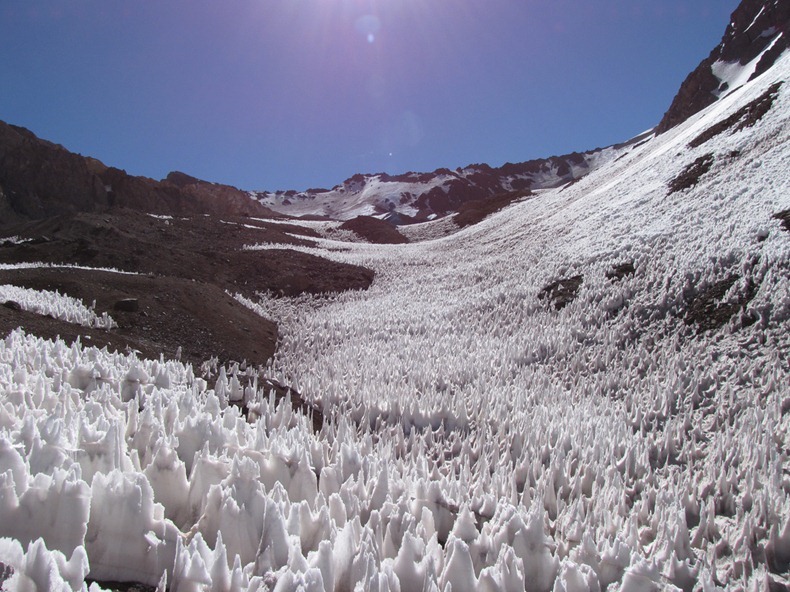If you wander over to the high-altitude regions of the Andes, you might spot fields of white figures, kneeling as if in prayer. Known as penitentes (based on the Spanish for penitent, one in penance), these are snow formations in the form of tall spikes.

First described in literature by Charles Darwin in his book *The Voyage of the Beagle*, penitentes are structures that form at altitudes higher than 4,000 meters in snow-covered regions of the Dry Andes. He encountered them on his way from Santiago to Mendoza, and reported the local belief that these eerie formations were caused by the winds.
This belief persisted while scientists came up with many alternative explanations such as electromagnetic orientation of snow, thermal eddies, and the descent of snow from landslides, none of which had proper backing until Lliboutry published his seminal “The Origina of Penitents” in the Journal of Glaciology. Lliboutry studied a region of penitentes and hypothesized that differential ablation was the cause of the structures.
Ablation refers to the combined processes removing ice from a glacier surface. The main loss of ice is a result of sunlight hitting it. Although it feels like a fair assumption that sunlight hits the ground evenly, because of the way light reflects, certain regions of the snow cover receive more light and conversely energy than others.
The crests remain cool enough to maintain their structure, but the valleys and spaces between individual penitentes have concentrated sunlight, causing them to wear down and melt over time. What starts off as random differences in the speed of melting snow cover accelerates into a spiky formation as more and more concentrated regions begin to melt over time.
Penitentes are an eerie sight to look at, and could potentially impact our travels in space too!
A 2018 paper by Hobley et al. theorized the presence on penitente-like structures on the surface of Europa, one of Jupiter’s moons. Europa is a promising target for astrobiology research due to its presence of a subglacial ocean, and the news of penitentes on its surface creates challenges for aerospace engineers designing landing gear. While the penitentes on Earth reach a meter or so tops, the modeled structures on Europa would be 15 meters tall!
Discussion and design of Europa landers has now shifted to consider penitentes, but their presence on Europa is still hotly contested. In a 2023 study, Warren goes in depth why the Hobley study might be incorrect. He contests that Hobley misrepresents Lliboutry’s statements, and that the evidence Hobley sites can be reattributed to subsurface irregularities.
The court is still out on whether or not penitentes are a hazard for flying to Europa, but they could still pose benefit to astrobiology research. A study in 2017 identified communities of microbes living at the tips of penitentes, sometimes giving them a reddish tint. This visual feature is something prominent in painted depictions of the structures. Studying the distribution of microbes here can be a valuable source of data for understanding the presence of bacteria in extreme environments.
Works Cited
Hobley, Daniel E. J., et al. “Formation of Metre-Scale Bladed Roughness on Europa’s Surface by Ablation of Ice.” Nature Geoscience, vol. 11, no. 12, 8 Oct. 2018, pp. 901–904, https://doi.org/10.1038/s41561-018-0235-0. Accessed 20 Apr. 2024.
Kaushik Patowary. “Penitentes: Peculiar Spikey Snow Formation in the Andes.” Amusing Planet, 25 May 2012, www.amusingplanet.com/2012/05/penitentes-peculiar-spikey-snow.html.
Kristine De Abreu. “Natural Wonders: Penitentes» Explorersweb.” Explorersweb, 11 Dec. 2022, explorersweb.com/natural-wonders-penitentes/.
Lliboitry, Louis. “The Origin of Penitents.” Journal of Glaciology, vol. 2, no. 15, 1954, pp. 331–338, www.cambridge.org/core/journals/journal-of-glaciology/article/origin-of-penitents/FACAAF8EF9A38B0F14AE85DC6805B8C7/core-reader, https://doi.org/10.3189/s0022143000025181. Accessed 20 Apr. 2024.
Solon, Adam J., et al. “Microbial Communities of High-Elevation Fumaroles, Penitentes, and Dry Tephra “Soils” of the Puna de Atacama Volcanic Zone.” Microbial Ecology, vol. 76, no. 2, 5 Jan. 2018, pp. 340–351, https://doi.org/10.1007/s00248-017-1129-1. Accessed 20 Apr. 2024.
Warren, Stephen G. “Snow Spikes (Penitentes) in the Dry Andes, but Not on Europa: A Defense of Lliboutry’s Classic Paper.” Annals of Glaciology, 23 Mar. 2023, pp. 1–5, https://doi.org/10.1017/aog.2023.12. Accessed 20 Apr. 2024.